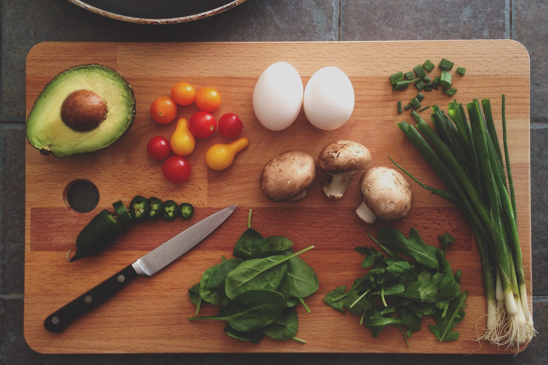
16 Simple Rules for Healthy Eating
All of us know about the benefits of eating healthier. Proper nutrition helps us prevent cancer, heart disease and other serious ailments. It allows us to lose weight and keep the pounds off. Eating healthier also helps to enhance our mood substantially and increases our chances of living longer and enjoying well-being while we are alive.
The problem, however, is that there is so much information out there pertaining to proper nutrition, and much of it conflicting. Some of the more popular diets include the Mediterranean diet, Atkins diet, paleo diet, vegetarian diet, vegan diet, raw food diet, South Beach diet, pescatarian diet, etc.
The proponents of each of these diets believe that theirs is the healthiest. We are constantly bombarded by news reports advocating certain types of foods while urging us to avoid others. And many of these suggestions contradict one another. For example, eggs are bad for us; eggs are good for us. Margarine is better than butter; butter is healthier than margarine. Eat more fish; eat less fish or none at all. Eat lean meat; avoid all meat. Be vegetarian; be vegan. Follow the Mediterranean diet; follow the Japanese diet. The list goes on and it can get extremely confusing and frustrating. That is why I decided to write this post.
I wanted to simplify the rules for eating healthier and make it simple for those who are interested in improving the way they eat. I researched many of the popular diets, news reports, and nutrition suggestions that are available. I visited respected medical web sites and watched scores of highly-rated documentaries. In addition to this, I also read books on nutrition while tapping into the experience I have gained by experimenting with various types of foods and diet philosophies. In fact, many of the rules I suggest overlap with what journalist and activist Michael Pollan (my hero) advocates (https://michaelpollan.com/).
What I have come up with is a few simple rules that I believe, if followed, will greatly improve the way we eat. Not only are these rules easy to understand, they are also somewhat flexible. Best of all, they allow us to eat almost anything we want (notice I said “anything we want” and not “as much as we want”). Even though the guidelines are simple, they are also extremely effective in helping us to eat better. So what are these rules?
Simple Rules For Healthy Eating
1. Eat Mostly Plants,Vegetables, Fruit, Nuts, Seeds and Legumes
This is probably the most important rule. Most of our food should consist of plants, vegetables, fruit, nuts, seeds and legumes, with the majority coming from plants, vegetables and fruit. My rule of thumb is 75% (by weight, not volume). And if you need convenience, you can get a plant-based meal delivery subscription.
2. Eat Real Food, Not Processed Food
It is best to eat foods in their natural state. Forget foods that are processed in a factory or plant. Some examples of processed foods are Cheetos, Pringles potato chips, white bread (bread is not supposed to be white in color), cereals, canned vegetables, canned meats, canned fruit, granola bars, candy bars, white sugar, bleached flour, beef jerky, soda, sports drinks, margarine (it is hydrogenated in a factory), packaged cookies, frozen dinners, processed meats like hot dogs, canned soups, fruit juices, ketchup, etc. Processed foods have been greatly modified and contain a lot of ingredients that do not exist in the food naturally. If you want to eat potato chips, buy real potatoes, slice them, and bake them yourself. If you want cookies, make them yourself at home. If you feel like eating chicken soup, cook it from scratch.
3. If You Eat Junk Food, Cook It Yourself
If you have to eat junk food, buy all the ingredients in their natural form and prepare it at home. For example, if you want to eat a hamburger, buy good ground beef and cook it at home. Instead of buying chicken nuggets from a restaurant, buy chicken breasts and prepare them at home. When you cook food at home, you can control what goes into each dish. I doubt any of us possess or would use chemical preservatives in dishes we prepare ourselves.
4. Eat a Variety of Different Foods
Each type of food ingredient that exists in nature has its nutritional makeup. When we eat different types of foods, we are more likely to get all the nutrients we need in order to be healthy.
5. Eat Meat and Fish in Moderation, as an Accompaniment, or on Special Occasions
Since rule number 1 involves deriving 75% of our food (by weight) from plants, vegetables, fruit, seeds, nuts and legumes, that means that 25% of less of our food should comprise meat and fish. For example, instead of eating a gigantic steak, stir fry a little beef with lots of vegetables. Instead of eating a pound of chicken, make a soup that consists mainly of vegetables, beans, and legumes, with the chicken as an accent.
6. Eat Fish and Animals That Have Been Treated Well and Eaten a Natural Diet
When you eat meat, try to ensure that the animal has been fed a natural diet and treated well. For examples, cows should eat grass (not soybeans or corn) and they should be free to graze. Chickens should forage naturally and not be kept in an over-crowded coop.
7. Stop Eating Before You Are Full
Instead of eating until you are completely full, stop eating before you feel completely satiated. It is ok (and healthy) to stop eating while you still have some room in your stomach. And do not forget, it takes a while for your stomach to send the message to your brain that you are full and have had enough to eat.
8. Eat at The Dining Table, Not in Your Car or at Your Desk
Always try to eat at a proper dining table. Never eat in your car or at your desk. When you make a point to sit down at a table and focus on your meal, you will be less likely to eat unconsciously. And food that is served to you through a window is almost never healthy. Following this rule also reduces the chances of eating when you are bored.
9. Avoid Foods That Are Prepackaged and Sold in a Can, Box, or Plastic Container
Healthy food almost never comes prepackaged in a box, can or plastic container. Most of this prepackaged food is stored in the middle of your grocery store. The healthiest foods that are unprocessed are generally stored and displayed around the sides of the grocery store, and that is where you should shop. If it has bright packaging that is screaming for your attention, walk right by it and don’t stop.
10. Eat Foods with 5 or Fewer Ingredients That a Kid Can Pronounce
If you take the time to read the ingredients in most processed and unhealthy foods, you will almost surely see that the list is long and contains lots of additives that you know little about. On the other hand, when your grandmother baked an apple pie or made chicken soup from scratch, she probably used 5 or fewer ingredients.
11. Eat Food That Has a Short Shelf-Life and Will Spoil
Healthy food does not contain a bunch of chemicals that preserve it and allow it to sit on a shelf for a year without going bad. If the food in question lasts for months, it is probably unhealthy for you.
12. Drink Water and Forget Everything Else
Water is the healthiest drink on the planet, period. Sodas, energy, and flavored drinks are the most unhealthy and they should be avoided at all costs. If you want to have a flavored drink, make lemonade using fresh lemons, or drink tea, or water flavored with fresh fruit and vegetables.
13. Salt and Sweeten Your Food Yourself
One of the reasons why some foods are so unhealthy for you is because of the excess salt and sugar. Whenever possible, try to season your food with salt and sugar yourself so that you can control the amount. Avoid foods with high-fructose corn syrup and MSG. For example, if you bake cookies, sweeten them yourself with some raw brown sugar or raw honey.
14. If You Eat Dessert, Eat Foods That Are Naturally Sweet
Many of us have a sweet tooth. I suggest eating dessert sparingly and, even then, eating sweet foods that nature provides us. Some good examples are blueberries, bananas, honey, mangoes, etc.
15. Cook More Than Eating Out
One of the best ways to eat healthier is to cook your own food. Besides saving a lot of money, you will also be able to control what goes into your food. You will not be using chemicals and other unhealthy additives.
16. Buy Organic When Possible
I am a proponent of consuming organic food whenever possible. That refers to food that is grown without harmful chemicals, hormones, and antibiotics. It also refers to food that is not genetically modified. While more research needs to be done on the benefits, I would rather be on the safe side and avoid food that may contain harmful elements. It is more nutritionally dense and also tastes much better.
So there you have it: you can eat much healthier simply by following the 16 rules listed above. And meat lovers can still enjoy meat and fish, albeit in moderation (remember the 75%-25% rule). It is an investment that will pay great dividends in the short and long run. And you deserve to be healthy.


